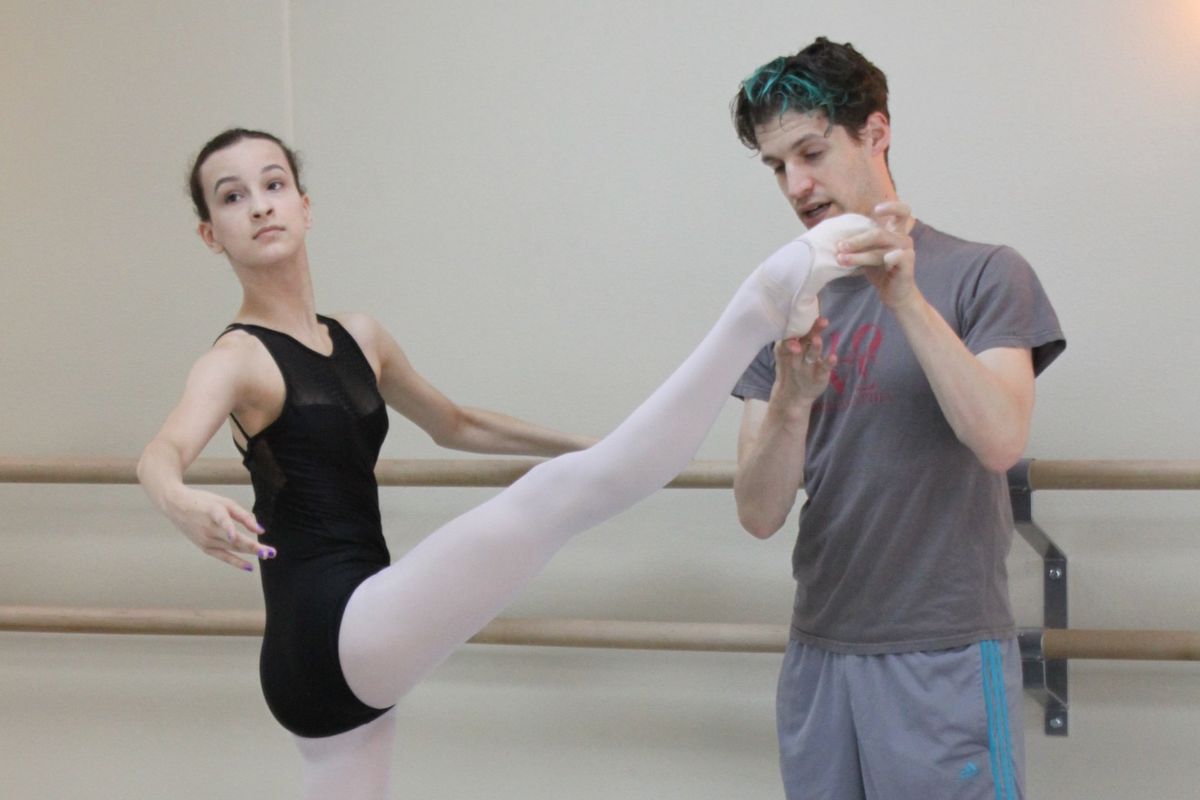
When it comes to teaching dance, few tools are more effective than hands-on corrections. As the COVID-19 pandemic has overtaken the globe, dance classes have either shifted to virtual platforms or socially distant classrooms where no physical contact is allowed. We’ve all had to adapt our teaching styles to ensure students continue to improve until we can return to business as usual.
For me, this has meant finding creative ways to have my ballet students self-correct issues that I’d normally address with a touch-based correction. Here are some of my favorite contactless “hands on” corrections I’ve been using:
The Point & Shift
What it corrects: Alignment; improper placement
How I explain it: If a student is struggling with a placement correction, I will ask them to point a finger on the joint I want them to move. Once we’ve noted the area that needs to be shifted, I have them move the pointed finger away from their body into the air where I want that joint to move. Then, I ask them to shift the joint over to the pointed finger in the air, moving them into proper placement.
The Tin Man
What it corrects: Transference of weight to the ball of the foot
How I explain it: Every generation knows The Wizard of Oz, so I often reference The Tin Man with students who struggle to shift their weight from their heels onto the ball of the foot. I start by discussing that iconic moment when Dorothy and The Scarecrow find The Tin Man in the woods. His joints are stiff, which causes him to lean from side to side, nearly falling over.
To show a student how to transfer their weight properly, I have them stand in first position and mimic The Tin Man, leaning side to side without picking up either foot. Once they have the hang of this, I have them practice “Tin Manning” onto their supporting leg as they release their working leg out to tendu.
The Cereal Bowl
What it corrects: Maintaining turnout when lifting the leg off the floor
How I explain it: Novice students often have difficulty maintaining their turnout to the front and side when lifting one leg off the ground. So, I have students put one hand out like they are holding a bowl full of cereal. We discuss how their cereal will only stay in the bowl if the hand remains underneath. If the bowl tilts, cereal will pour all over the floor.
Next, I note that the shape of their glutes can also fill the bowl. I then have students take their hand and hold one of their glutes to fill the cereal bowl. As they lift their leg off the ground, they have to keep the bowl facing up. If the leg loses rotation and turns in, the bowl turns sideways and their cereal spills.
The Resist Yourself
What it corrects: Sagging retiré
How I explain it: Many students have a nice lift in their leg as they move from 5th position through coupé up to retiré. But once they arrive in this bent knee position, it droops and looks heavy. To stop this, I have students use their hand to push down against the top of their knee at the height of their retiré to create resistance without dropping their working leg. This push shows students the energy required to properly hold their leg in this essential position.
The Dreidel
What it corrects: Shoulder rotation in preparing for multiple pirouettes
How I explain it: There are a few common issues that arise when students execute pirouettes. One of these involves creating torque with the upper body for multiple rotations. Often, students focus more on their arms when they should be thinking about their shoulders.
To make my point, I ask students to find a dreidel (or top) to spin. When spinning a dreidel, there is always one of three outcomes. If you don’t twist your fingers evenly, the top spins out fast and flies across the table. If you twist your fingers too slowly, the top spins a few times before it wobbles and falls over. But if you twist your fingers evenly with a sharp, aggressive twist, the top spins quickly for an extended period of time in one spot until it calmly ceases to rotate.
Once a student understands this concept, I have them focus on their shoulders as if they are their fingers turning the top. If turning en dehors to the right, students will pull their right shoulder back sharply as they abruptly push their left shoulder forward like their fingers spinning the top. This creates an even rotation of the upper body and offers students a fighting chance to execute multiple pirouettes.
The Tendu that Went Too Far
What it corrects: Creating length in legs
How I explain it: Many students don’t see the correlation between tendu, jeté, grand battement, or any extension that ends with a straight knee. In reality, anything off the ground is just a tendu that has gone too far. To clarify this concept, I have students stand in tendu devant. We pick a point on the floor directly in front of them that is impossible to touch. Then, I have them try to touch that spot without shifting anything except reaching their big toe to that point. Once they know they can’t reach any further, I ask them to allow the working leg to rise off the floor and to try to reach their shadow over the impossible point on the floor. Once the student accomplishes this to the height of a jeté, we work up to 90 degrees. This exercise can be executed in all directions. Just make sure students don’t shift their hips to reach the point on the floor.
The Rubber band
What it corrects: Quality of rond de jambe en l’air
How I explain it: For students with access to a TheraBand, I have them tie it in a loop around their ankles in fifth position (leaving a bit of space in the loop). Students then lift their working leg to 45 degrees à la seconde. With the tension of the extended band around their ankles, dancers execute rond de jambe en l’air in both en dehors and en dedans directions. Students will feel a quick pull as they rond de jambe in and a slow push outward as they extend back out. (I do not recommend this exercise at 90 degrees for safety purposes.)
The Flashlight
What it corrects: Head placement
How I explain it: I’m always a bit surprised to find that most students don’t understand why épaulement is so important. It is all about stage lighting! If a student is struggling to find the proper angle of their head and neck, I have them grab their phone, turn the lights in their room off and their flashlight on, and look in a mirror. If the student holds the flashlight at a high angle in front of their face like a spotlight, it will put shadows on parts of their face. I ask students to focus on getting the shadows off of their eyes, cheeks and neck by having them lift their chin, turn their head and raise their cheek forward. When properly executed, the student should be able to see most of their facial features without too many shadows obscuring them.




